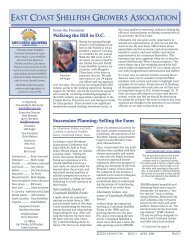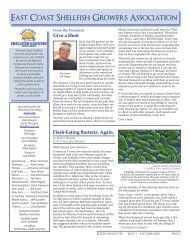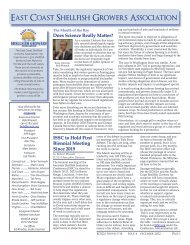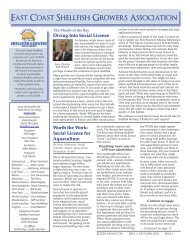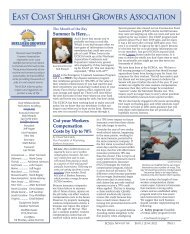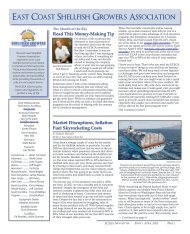East Coast Shellfish Growers Association June 2024 Newsletter
You also want an ePaper? Increase the reach of your titles
YUMPU automatically turns print PDFs into web optimized ePapers that Google loves.
CDC Improves Its<br />
Website<br />
by Robert Rheault,<br />
ECSGA Executive Director<br />
It seems as if every few years we<br />
see an explosion of news articles<br />
about flesh-eating bacteria, a<br />
sensational topic that is irresistible<br />
to members of the media.<br />
Invariably these incidents result<br />
from Vibrio vulnificus illnesses<br />
caused by wound infections<br />
contracted while swimming in<br />
warm, brackish water. V. vulnificus<br />
infections are incredibly<br />
rare (156 total cases reported in<br />
2019) and only 10% are associated<br />
with eating seafood. But<br />
notably, V. vulnificus infections<br />
have a 20% mortality rate in<br />
immune-compromised patients.<br />
The go-to source for reporters<br />
looking for information about<br />
flesh-eating bacteria is the Centers<br />
for Disease Control and Prevention<br />
(CDC) website where,<br />
until recently, visitors saw that<br />
an estimated 80,000 vibriosis<br />
cases occur each year, and that<br />
oysters are commonly implicated.<br />
The fact that only 15 or so of<br />
the extremely rare V. vulnificus<br />
cases are linked to oysters got<br />
lost in the confusing language<br />
that made it hard to distinguish<br />
the generic term “vibriosis”<br />
from V. vulnificus infections,<br />
so just about every media story<br />
on flesh-eating bacteria showed<br />
pictures of oysters and cited<br />
“80,000 cases a year.”<br />
When three people died of V.<br />
vulnificus wound infections in<br />
the summer of 2023 after swimming<br />
in Long Island Sound, I<br />
counted more than 47 breathless<br />
news reports and watched in<br />
horror as oyster markets in New<br />
York evaporated. I arranged a<br />
meeting with CDC press relations<br />
folks requesting substantive<br />
changes to their website to clarify<br />
the rarity of the disease and to<br />
emphasize that the overwhelming<br />
majority of V. vulnificus<br />
cases are wound-related. They<br />
rejected our suggested edits. On<br />
our Walk the Hill trip to D.C. in<br />
March we brought up the issue<br />
with our congressional colleagues,<br />
and later began working<br />
on a letter that representatives<br />
could send to the CDC urging<br />
the agency to make changes to<br />
its website.<br />
To its credit, in recent months<br />
the CDC has overhauled its<br />
Vibrio pages and they are now<br />
much clearer and easier to<br />
understand. I’d like to think that<br />
all our hard work advocating<br />
for changes to the website paid<br />
off, but who knows? Maybe the<br />
revamp had been in the works<br />
for some time. In any event, the<br />
improvements are noticeable.<br />
For example, on the About<br />
Vibrio 1 page, key points are<br />
highlighted right off the bat:<br />
• Vibrio are bacteria that naturally<br />
live in coastal waters.<br />
• About a dozen kinds of<br />
Vibrio can cause people to get an<br />
infection called vibriosis.<br />
• People can get vibriosis after<br />
swallowing Vibrio or getting it in<br />
a wound.<br />
• Vibrio infection can be serious.<br />
Know when to seek medical<br />
care.<br />
In addition to the simplified Vibrio<br />
presentations for members<br />
of the public and the media, the<br />
National Outbreak Reporting<br />
System (NORS) infection and<br />
outbreak data are now accessible<br />
online in the NORS Dashboard 2<br />
and can be downloaded to a<br />
monster csv file for massaging<br />
with your favorite spreadsheet<br />
application.<br />
—Continued on page 18<br />
CDC/ JANICE H. CARR<br />
Vibrio vulnificus infections<br />
are very rare (156 cases<br />
in 2019) and only 10% are<br />
linked to eating seafood.<br />
ECSGA <strong>Newsletter</strong> Issue 2 <strong>June</strong> <strong>2024</strong><br />
Page 15



